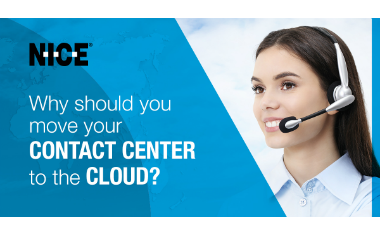"Hi, my name is Liron and I'm a cloudoholic". There I said it.
Cloud is one of the most popular topics talked about today. Before I start explaining why I'm a 'cloudoholic', let me define the term.
So what is this cloud?
The National Institute of Standards and Technology (NIST) definition of Cloud reads: "Cloud computing is a model for enabling ubiquitous, convenient, on-demand network access to a shared pool of configurable computing resources (e.g., networks, servers, storage, applications, and services) that can be rapidly provisioned and released with minimal management effort or service provider interaction".
Now try to say that in a single breath! :-)
As I mentioned, I'm a huge advocate of Contact Center as a Service (CCaaS). Why you ask would something like that excite me? Well…why buy the cow if you can buy the milk ONLY when you want to buy the milk?
The benefits of CCaaS can be easily illustrated by the taxi cab analogy. Instead of buying a car, paying for parking, maintenance and gas, you can order a taxi only when you when need it and you pay for the taxi only for just the route you need to take. The biggest benefit of using the taxi cab is that there are ZERO overhead costs incurred. Think about it.
The same goes for CCaaS.
The benefits of CCaaS
It has now become crystal clear to enterprises that by adopting a cloud strategy your organization will result in a growing amount of contact centers and back offices that will fully reap the core benefits of a CCaaS deployment. These include:
- Automatic Scaling: Contact centers and business operations are often seasonal, with bursts of volume during holidays or other peak periods. When software is delivered via SaaS, it is possible to expand and contract your license count to always match your workforce, thereby controlling costs.
- Agility! Rather than spend your time readying your hardware footprint and configuring the solution, you can turn it on and go.
- Focus on innovation and not integration - Unified and integrated to deliver continuous and automatic improvement, a system that is smart enough to self-learn and adapt itself automatically, based on its own insight.
- Stay compliant: Cloud delivery ensures you have access to the newest releases and most advanced capabilities.
OK...but why should you act now?
The answer is that "Good things will NOT come to those who wait".
Let me stop here for a moment, this is the perfect place to clear up a common misconception that cloud isn't "all or nothing". For example, many customer service leaders when considering moving to the cloud make the assumption that their organization will need to move all the moving pieces from Automatic Call Distribution (ACD) and component applications of their Workforce Optimization suite (WFO), to the cloud at the same time.
I believe that the contact center cloud migration is a journey, and like every journey, there are two critical elements – who you partner with along the way and where to start.
The first one is no-brainer. The last thing anyone wants to be is a guinea pig. You carefully do your homework and partner with a leading vendor, one that lives and breathes CCaaS. A vendor that has a proven track record and one you can trust.
NICE inContact CXone is a customer experience platform that combines smart omnichannel routing, advanced analytics, adaptive workforce optimization, robotic automation, and AI, all based on an open native cloud foundation. CXone helps organizations better understand their customers, engage their employees, and improve their processes to improve customer satisfaction and Net Promoter Score while increasing sales, reducing operational costs, identifying risks, preventing fraud, and ensuring compliance.
The second critical element is choosing your starting point. This can vary for different enterprises as you can imagine.
Three steps to a successful cloud migration:
- First, keep your existing application and WFO infrastructure intact, as you move your omnichannel routing to the cloud. Do it for small sites first, so you can learn how simple this process is. Eventually you'll make the change to omnichannel routing in the cloud everywhere.
- Then, take advantage of any applications and features you currently do not have, such as analytics, Customer Journey Optimization, Performance Management and more by purchasing them in SaaS model.
- Finally, based on your own timelines and maturity level, migrate your current WFO applications to the cloud platform for a single, unified and integrated SaaS cloud solution.
Do you want to learn more on how NICE inContact CXone can fit your enterprise?
We'd love to spend some time with your teams and work together to put a strategic plan in place that is right for your organization.In the meantime, you can check our NICE inContact CXone offering here.



